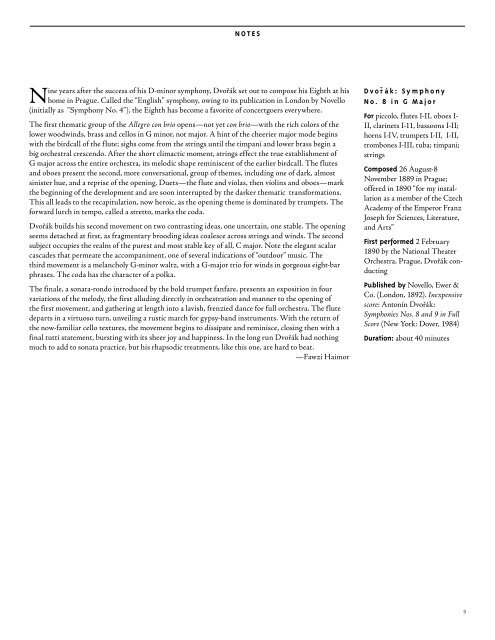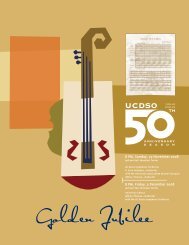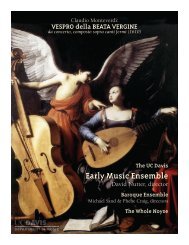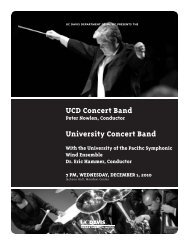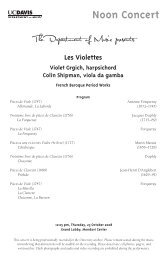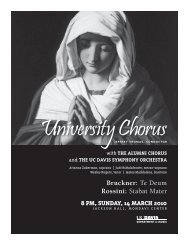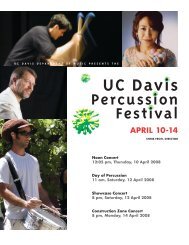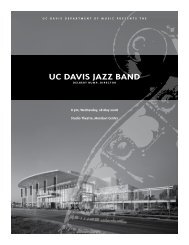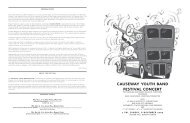to get the file - UC Davis: Department of Music - University of ...
to get the file - UC Davis: Department of Music - University of ...
to get the file - UC Davis: Department of Music - University of ...
Create successful ePaper yourself
Turn your PDF publications into a flip-book with our unique Google optimized e-Paper software.
n o t e s<br />
Nine years after <strong>the</strong> success <strong>of</strong> his D-minor symphony, Dvorˇák set out <strong>to</strong> compose his Eighth at his<br />
home in Prague. Called <strong>the</strong> “English” symphony, owing <strong>to</strong> its publication in London by Novello<br />
(initially as “Symphony No. 4”), <strong>the</strong> Eighth has become a favorite <strong>of</strong> concertgoers everywhere.<br />
The first <strong>the</strong>matic group <strong>of</strong> <strong>the</strong> Allegro con brio opens—not yet con brio—with <strong>the</strong> rich colors <strong>of</strong> <strong>the</strong><br />
lower woodwinds, brass and cellos in G minor, not major. A hint <strong>of</strong> <strong>the</strong> cheerier major mode begins<br />
with <strong>the</strong> birdcall <strong>of</strong> <strong>the</strong> flute; sighs come from <strong>the</strong> strings until <strong>the</strong> timpani and lower brass begin a<br />
big orchestral crescendo. After <strong>the</strong> short climactic moment, strings effect <strong>the</strong> true establishment <strong>of</strong><br />
G major across <strong>the</strong> entire orchestra, its melodic shape reminiscent <strong>of</strong> <strong>the</strong> earlier birdcall. The flutes<br />
and oboes present <strong>the</strong> second, more conversational, group <strong>of</strong> <strong>the</strong>mes, including one <strong>of</strong> dark, almost<br />
sinister hue, and a reprise <strong>of</strong> <strong>the</strong> opening. Duets—<strong>the</strong> flute and violas, <strong>the</strong>n violins and oboes—mark<br />
<strong>the</strong> beginning <strong>of</strong> <strong>the</strong> development and are soon interrupted by <strong>the</strong> darker <strong>the</strong>matic transformations.<br />
This all leads <strong>to</strong> <strong>the</strong> recapitulation, now heroic, as <strong>the</strong> opening <strong>the</strong>me is dominated by trumpets. The<br />
forward lurch in tempo, called a stret<strong>to</strong>, marks <strong>the</strong> coda.<br />
Dvorˇák builds his second movement on two contrasting ideas, one uncertain, one stable. The opening<br />
seems detached at first, as fragmentary brooding ideas coalesce across strings and winds. The second<br />
subject occupies <strong>the</strong> realm <strong>of</strong> <strong>the</strong> purest and most stable key <strong>of</strong> all, C major. Note <strong>the</strong> elegant scalar<br />
cascades that permeate <strong>the</strong> accompaniment, one <strong>of</strong> several indications <strong>of</strong> “outdoor” music. The<br />
third movement is a melancholy G-minor waltz, with a G-major trio for winds in gorgeous eight-bar<br />
phrases. The coda has <strong>the</strong> character <strong>of</strong> a polka.<br />
The finale, a sonata-rondo introduced by <strong>the</strong> bold trumpet fanfare, presents an exposition in four<br />
variations <strong>of</strong> <strong>the</strong> melody, <strong>the</strong> first alluding directly in orchestration and manner <strong>to</strong> <strong>the</strong> opening <strong>of</strong><br />
<strong>the</strong> first movement, and ga<strong>the</strong>ring at length in<strong>to</strong> a lavish, frenzied dance for full orchestra. The flute<br />
departs in a virtuoso turn, unveiling a rustic march for gypsy-band instruments. With <strong>the</strong> return <strong>of</strong><br />
<strong>the</strong> now-familiar cello textures, <strong>the</strong> movement begins <strong>to</strong> dissipate and reminisce, closing <strong>the</strong>n with a<br />
final tutti statement, bursting with its sheer joy and happiness. In <strong>the</strong> long run Dvorˇák had nothing<br />
much <strong>to</strong> add <strong>to</strong> sonata practice, but his rhapsodic treatments, like this one, are hard <strong>to</strong> beat.<br />
—Fawzi Haimor<br />
D v o rˇ á k : s y m p h o n y<br />
n o . 8 i n G m a j o r<br />
for piccolo, flutes I-II, oboes I-<br />
II, clarinets I- , bassoons I-II;<br />
horns I-IV, trumpets I-II, I-II,<br />
trombones I-III, tuba; timpani;<br />
strings<br />
composed 6 August-8<br />
November 889 in Prague;<br />
<strong>of</strong>fered in 890 “for my installation<br />
as a member <strong>of</strong> <strong>the</strong> Czech<br />
Academy <strong>of</strong> <strong>the</strong> Emperor Franz<br />
Joseph for Sciences, Literature,<br />
and Arts”<br />
first performed February<br />
890 by <strong>the</strong> National Theater<br />
Orchestra, Prague, Dvorˇák conducting<br />
published by Novello, Ewer &<br />
Co. (London, 89 ). Inexpensive<br />
score: An<strong>to</strong>nín Dvorˇák:<br />
Symphonies Nos. 8 and 9 in Full<br />
Score (New York: Dover, 984)<br />
Duration: about 40 minutes<br />
5


